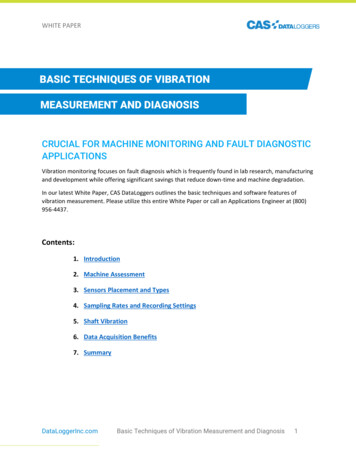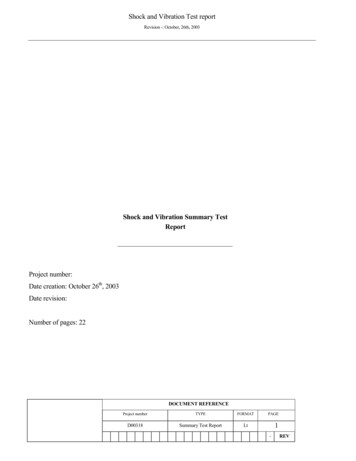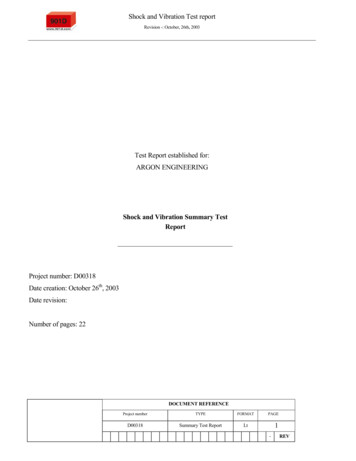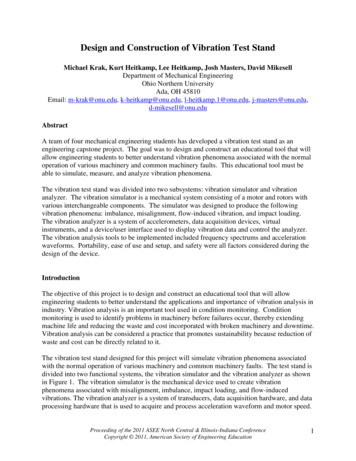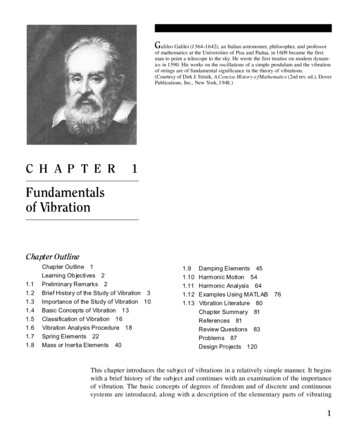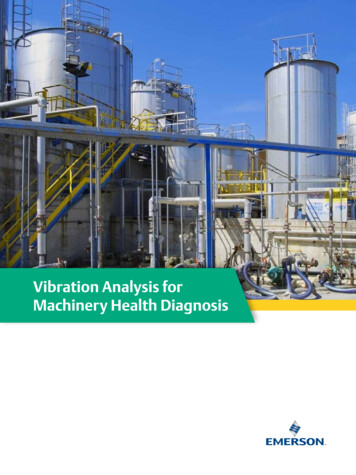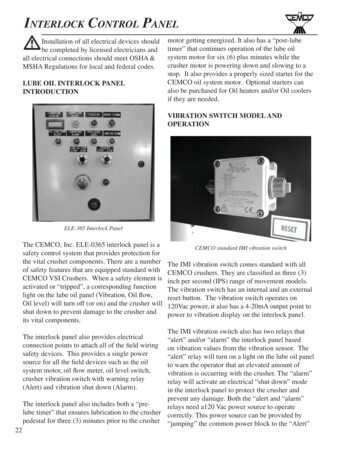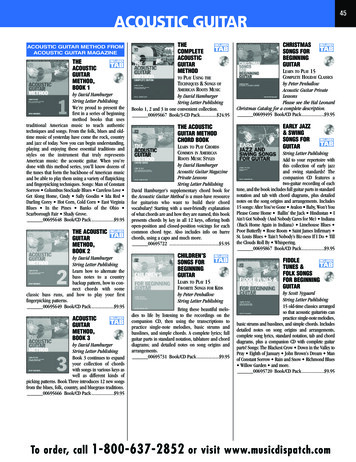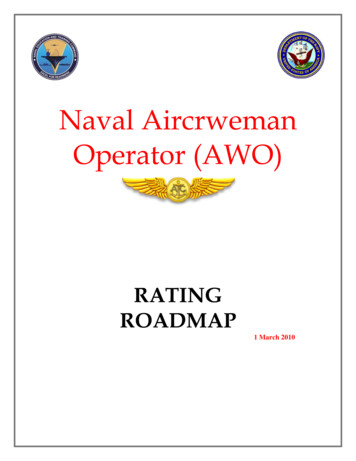
Transcription
Vibration and Acoustic Test Facility (VATF)User Test Planning GuideNational Aeronautics and Space AdministrationLyndon B. Johnson Space CenterHouston, Texas 77058
Table of Contents1.0Vibration and Acoustic Testing .42.0Facility Layout .53.0Safety and Health .64.0Test Process Flow .64.1Export Controlled and Proprietary Information.84.2Test Initiation Phase .94.2.1Test Request . 94.2.2Schedule and Cost Estimate . 94.3Test Preparation Phase .104.3.1Test Requirements . 104.3.2Test Documentation . 124.3.3Test Schedule . 144.3.4Test Plan . 144.3.5Test Article Delivery . 144.3.6Test Readiness Review . 154.4Test Execution Phase.164.4.1Test Authority . 164.4.2Test Deviations . 164.4.3Facility Equipment . 174.5Test Closeout Phase .174.5.1Customer Feedback . 175.0Facility Access .186.0Roles and Responsibilities .19Acronyms .20Appendices .22Appendix AVATF Capabilities .24A.1General Capabilities . 24A.2Vibration Capabilities . 25A.3General Vibration Lab Capabilities . 27A.4Spacecraft Vibration Laboratory Capabilities . 29A.5Vibro-Acoustic Capabilities . 31A.6Spacecraft Acoustic Laboratory Capabilities . 32A.7Sonic Fatigue Laboratory Capabilities . 332
A.8Modal Operations Laboratory Capabilities . 34Appendix BVATF Facility Interfaces .35B.1General Facility Interfaces . 35B.2GVL Facility Interfaces . 36B.3SVL Facility Interfaces . 38B.3SVL Facility Interfaces . 38B.4SAL Facility Interfaces . 40B.5SFL Facility Interfaces . 43Appendix CVATF Fixture Interfaces .45C.1GVL Fixture Interfaces . 45C.2SVL Fixture Interfaces . 47C.3SAL Fixture Interfaces . 48C.4SFL Fixture Interfaces. 49C.5MOL Fixture Interfaces . 50Appendix DSample Test Configurations .51D.1GVL Sample Test Configurations . 51D.2SVL Sample Test Configurations . 52D.3SAL Sample Test Configurations . 53D.4SFL Sample Test Configurations . 54D.5MOL Sample Test Configurations . 55Appendix EForms .56E.1Test Request Worksheet – VATF . 56E.2Test Requirements Worksheet – Example . 61E.3Test Article Hazard Checklist – VATF . 66E.4Test Article Hazard Checklist – Example . 68E.5Laboratory Performance Evaluation . 70Appendix FPersonnel Certification Memorandum – Example.713
1.0 Vibration and Acoustic TestingThe Vibration and Acoustic Test Facility (VATF) at the Johnson Space Center (JSC) is aversatile, dynamic structural test facility located in JSC Building 49 to perform non-hazardoustesting. Please consult with the VATF Lab Manager to determine if your test is consideredhazardous.Five laboratories are housed under the VATF: General Vibration Laboratory (GVL)Modal Operations Laboratory (MOL)Sonic Fatigue Laboratory (SFL)Spacecraft Acoustic Laboratory (SAL)Spacecraft Vibration Laboratory (SVL)These laboratories provide testing for the following: Development/EvaluationQualification (design verification) CertificationAcceptance (workmanship) CertificationProto-Flight CertificationOperational or Flight Anomaly InvestigationsTrade StudiesThe facility can perform a wide range of tests needed toevaluate all aspects of structural dynamics including thefollowing: VibrationVibro-acousticsModal CharacteristicsSound Transmission LossShockThe facility provides the capability to performtesting of both aerospace and non-aerospacehardware. Capabilities include testing ofcomponents as small as a few ounces to aslarge as complete structures or systems. Thespecific capabilities and features of eachlaboratory are detailed in Appendix A.Point of ContactVATF Lab Manager, Peter FantasiaJohnson Space Center2101 NASA Parkway, Houston, TX 77058(281) 483-8967peter.m.fantasia@nasa.gov4
2.0 Facility LayoutBelow are a picture and a diagram of the facility. Details of clearances and interfaces within thefacility are located in Appendix B.5
3.0 Safety and HealthSafety is an integral part of the culture at the National Aeronautics and Space Administration(NASA). Management, leadership, and employee involvement from all organizations is criticalto the success of NASA′s safety program. In order to ensure personal safety, as well as a safetest environment throughout the process, the Test Requester shall furnish the VATF team witheither a Hazard Analysis of the test article and its test support equipment or the informationnecessary to perform a hazard assessment of the test article and its test support equipment.Additionally, while visiting JSC, the requester shall follow all facility-specific safety and healthrequirements. A succinct briefing on the Emergency Action Plan and Emergency TestProcedures will be provided to all personnel prior to the start of the test. The safety briefing willinclude a review of the VATF safety rules and potential hazards.4.0 Test Process FlowThe flowchart presented below outlines the basic roadmap and significant milestones betweenthe initial test request and delivery of test data. The flow is separated between Test Requesteractions and Facility actions, highlighting interactions and inputs between the Test Requesterand the Test Director.6
The test schedule for a particular project in the VATF is dependent on the complexity and scopeof the test and on laboratory availability. For time-critical testing, this schedule may beaccelerated when feasible or practical.The structural dynamic tests are typically scheduled on a first-come, first-served basis, unlessspecific priorities are set by management so that critical hardware testing could override thispolicy. In the unlikely event of schedule conflicts with another Test Requester, the VATF willnegotiate the structural dynamic test schedules on the behalf of all Test Requesters involved.A detailed schedule shall be developed following a review of the test objectives andrequirements. Major milestones are presented below:Note: The schedule is subject to the complexity of test requirements.7
A chronological order of tasks that the Test Requester should perform in preparation for astructural dynamic test is presented below. To maintain the integrity of your test schedule,please follow the chronological order of these tasks. The times may be significantly shorter for atest preparation for identical hardware previously tested in the VATF.RequirementWhen to SubmitRoleTest Request WorksheetAs soon as desired test dates are knownTest RequestorRequirements andDocumentationShortly after submitting Test RequestTest RequestorRequirements ReviewFollowing work authorizationTest RequestorTest DirectorTest Article HazardAssessmentSubmit with Test Request Work SheetTest RequestorTest Plan / ProceduresApproved prior to Test Readiness Review (TRR)Test DirectorTest Assembly DrawingsComplete prior to TRRTest RequestorShortly before TRRTest RequestorTest DirectorBefore or During TRRTest RequestorDuring TRRTest RequestorTest Article/Fixture/AdapterFit CheckPersonnel CertificationMemorandumNo Constraint to TestDocumentation4.1Export Controlled and Proprietary InformationThe VATF provides for protection of proprietary information and hardware throughout the testprocess. The Test Requester shall clearly mark all proprietary hardware items and dataprovided with a notice of restriction on disclosure or usage. The Test Director and VATF teamshall safeguard proprietary items from unauthorized use and disclosure and ensure that testarticles remain secure within the facility and are properly sequestered. Hardware items shall bereturned to the Test Requester or disposed of in accordance with the Test Requester′sinstructions at the completion of the test activity.8
4.2Test Initiation PhaseThe test initiation phase establishes the relationship between the Test Requester and the TestDirector. The Test Requester shall provide a test request to the Test Director, which will beused to determine test feasibility, to develop an estimated cost, and to establish a preliminarytest schedule. An initial requirements review meeting may be necessary in order to discuss thecharacteristics of the test article, the test approach, or any special considerations for the test.An onsite tour of the VATF is highly recommended for familiarization and to provide anopportunity for an exchange of technical information.Inputs:Test Requester provides test request, identifies Test Article ExpertActivities:Test Director reviews test request to determine test feasibilityOutputs:Facility delivers preliminary test plan, including assumptions; estimated cost; andschedule to Test Requester4.2.1 Test RequestThe test request outlines the test objectives, technical details, and schedule. A blank TestRequest Worksheet and a completed example are provided in Appendix E (sections E.1 andE.2, respectively). This worksheet provides VATF with a summary of the requested testrequirements and will greatly aid in writing the Test Requirements Document and filling out theTest Request Form (Form 90). It addresses the basic requirements for testing in the VATF.Complete this worksheet and submit it to the Test Director. If you need assistance with thisform, contact your Test Director. At a minimum, the test request should include the basicrequirements defined in section 4.3.1.Note: JSC personnel will complete the Test Request Form (Form 90) for external TestRequesters.4.2.2 Schedule and Cost EstimateA cost estimate and preliminary test schedule, including major milestones, will be delivered tothe Test Requester following receipt of the Test Request Worksheet.9
4.3Test Preparation PhaseThe Detailed Test Plan or Procedure and the Test Schedule are finalized during the testpreparation phase. The Test Requester shall provide detailed test requirements and test articledocumentation to the Test Director. A TRR will be held following approval of the test plan.Inputs:Test Requester provides test requirements and test article documentation (seesection 4.3.2)Activities:Facility develops structural dynamics test plan/procedure, initiates assembly offacility interface/support structure(s)Test Requester develops functional test plan/procedure (if applicable),ships/transports test article/equipment to JSCOutputs:Test Requester approves structural dynamics test plan/procedure and final testscheduleFacility holds TRR4.3.1 Test RequirementsA complete understanding of test requirements is essential for a successful test. Testrequirements must be defined and reviewed so that the VATF team understands the effect ofthe requirements on test facility preparation. The Test Requester shall provide a detailed list oftest requirements, including, but not limited to, the following:Test ObjectiveA brief description of the test requirements including, but not limited to: Type of test Specific test conditions Proposed test approach (input excitation) Test data requirements (data type, data format, # of channels, sample rate, frequencyof analysis, frequency resolution, # of measurements, single or multi-axismeasurements, type of analysis) Test parameters (G levels, duration, frequency, spectral density, sound pressure level,boundary conditions)Technical DetailsA brief description of the technical details (drawings, sketches, and/or photos are helpful) including, but not limited to:Test article characteristics [mass, center of gravity (CG),volume, materials] Test configuration [orientation of hardware (x, y, z), active or inert]10
Special considerations [hazards, cleanliness, electro-static discharge (ESD), functionaltests] Handling and storage requirements (method of suspension/support, environmentrequired) Test article interfaces (structural, mechanical, electrical)* Assembly and installation requirements Utility requirements (power, shop air, cooling) Existing test article fixture(s) and/or adapter(s) Test support hardware being used Party responsible for supplying specific equipment* Details of the facility interfaces are located in Appendix B.ScheduleIdentify the required start date and proposed date for test completion.Test Article Fixture RequirementsThe VATF maintains a limited number of fixtures to support general, non-complexgeometries. Please consult with the Test Director prior to designing your fixtures. In somecircumstances, dedicated fixtures may not be necessary for your test, due to existing testfixtures or because of innovative mounting techniques. The interface details for existing testfixtures are included in Appendix C. Coordination between the Test Requester and theVATF team should begin very early in the process, as the design and fabrication of testfixtures and/or adapters can be more time consuming than initially anticipated.For new test fixture requirements, an initial fixture concept and design coordination meetingwith the VATF team is highly suggested in order to avoid setup or testing problems. Furtherconsultation with the VATF team should occur during final design of the fixture to ensure thatan adequate and workable fixture design has been accomplished. It is highly recommendedthat the Test Requester make an appointment with the VATF team to perform a fit check onthe laboratory test beds following completion of the test fixture. The fit check appointmentshould be scheduled prior to the TRR.11
4.3.2 Test DocumentationWe can accept documentation through a File Transfer Protocol (FTP) site, by e-mail, or viastandard mail.1. The Test Director will send an invitation to the NASA FTP site to upload and send files.2. E-mail files to the Test Director or, if the Test Director has not been assigned, to theVATF Laboratory Manager.3. Mail documentation to the following address:National Aeronautics and Space AdministrationAttention Peter Fantasia (Mail Code: ES6)Lyndon B. Johnson Space Center2101 NASA ParkwayHouston, Texas 77058Test Request WorksheetThis worksheet is necessary to ensure that the test plan/procedure meets the TestRequester’s requirements. See section 4.2.1 for details. Completion of this form is the TestRequester’s responsibility.Test Plan/ProcedureA Test Plan or Test Procedure is necessary to ensure that all requirements of the TestRequester and the VATF are achieved in an efficient and reproducible manner. Seesection 4.3.4 for details. A work authorizing document (WAD), such as Work Orders or aTask Performance Sheet (TPS) (Form 1225C), which contains the required information, maybe used by the VATF as a Test Plan or Procedure provided it expedites the execution of thetest while maintaining its integrity. If there are any functional tests or specific inspections tobe conducted prior to, during, or after a test, the Test Requester will provide thoseprocedures.Note: The final Test Plan or Procedure should take the form of a step-by-step instructionrather than an e-mail or an engineering memorandum.DrawingsThe Test Requester shall provide detailed drawings or precision sketches of the test article,any provided test fixture, and an integrated drawing (test setup) showing the test article, testfixture (indicate axis definition), and representation of the test bed interface, as requested bythe VATF. The drawings/sketches should be either isometric or a three-view format whenpossible. Proper dimensioning is required to define the installation of the test article on thetest bed, to define the axis of excitation when applicable, and to locate test articleinstrumentation. At a minimum, the drawing or precision sketch of the test article, showingaxis designations, is required as part of, or as an attachment to, the Test Plan.12
Material Safety Data Sheets (MSDS)NASA must ensure that all materials exposed to test environments do not present a hazardto personnel or the test facility. The Test Requester shall deliver to the facility MSDS formaterials used in the construction or operation of the test article. The MSDS shall bedelivered prior to delivery of the test article. The Test Director will review the materials listfor compatibility with the test environment.Integrated Hazard AnalysisThe safety of facility personnel, facility equipment, and the test article is imperative to NASA.Potential hazards, material compatibility, and facility interfaces will be reviewed with thefacility prior to testing. In certain instances, special precautions must be taken, due to theseverity level of these potential hazards. The Test Requester shall complete the Test ArticleHazard Checklist [included in Appendix E (section E.3)] or to provide a test article hazardanalysis. The checklist should list all hazards associated with the presence and operation ofthe test article as well as any associated test support equipment. The checklist should becompleted from the perspective of the hazards the requester’s hardware presents includingany damage to which it is susceptible. A Test Article Hazard Analysis (HA) for the test articleand support equipment will be prepared by the Test Director if not provided by the TestRequester.The VATF will address hazards that the facility and its laboratories may present and willintegrate all components relative to the tests into an Integrated Hazard Analysis (IHA) toidentify any additional hazards that any component may present to another.Refer to the Test Article Hazard Checklist to assess what hazards associated with the testarticle and its support equipment that would result in personal injury or damage to hardware.The Test Article Hazard Checklist must be received to provide adequate time to supportcompletion of the IHA prior to the TRR.Personnel Certification MemorandumTo protect the integrity of the test and test article, a Personnel Certification Memorandum,signed by the manager responsible for the test article, is required to identify all test articlepersonnel with test decision authority and responsibility. Only those test article personnellisted on this memorandum will have the authority to make test decisions with regard to theirhardware during the test operations. An example personnel certification memorandum isprovided in Appendix F.Test Request Form (Form 90) – for internal use onlyThis form is used by JSC as a formal means of requesting a test within JSC. It is the WADfor VATF personnel to provide you support.13
No Constraint to Test DocumentationSimple documentation, declaring no constraint to test, is required to verify that there are noissues that would invalidate the structural dynamic test. The TRR Summary Sheet(Form 1850) is one version of such documentation for internal Test Requesters.4.3.3 Test ScheduleA detailed schedule shall be developed by the Test Director and approved by the TestRequester. The schedule shall allow adequate time for review and approval of testrequirements, assembly of facility interfaces/structures, and delivery of the test article. Theschedule of other tests and maintenance activities will be reviewed and potential conflicts shallbe addressed by the Test Director.4.3.4 Test PlanA Test Plan or Test Procedure for the structural dynamic test will be prepared by the TestDirector, unless one is submitted by the Test Requester. The final test plan or procedure shallbe approved by the Test Requester with concurrence from the Test Director. The test plan willbe the controlling document, with respect to scope and approach for the test program. The testplan will include, at a minimum, the following: Test objectives Test article description Scope of the tests Test environment (such as desired test spectrum) to be imposed on the test article Installation of the test article on the test beds Safety considerations Data requirementsChanges to the test plan that occur after the TRR that result in a major change to the scope ofthe test or that present new hazards may require a delta TRR.4.3.5 Test Article DeliveryThe test article delivery date will be determined on a case-by-case basis. An agreed-upondelivery date shall be captured as a milestone in the test schedule. The Test Requester shallprovide detailed handling instructions prior to delivery of the test article, including handlinghazards, cleanliness and storage requirements. The test article shall be secured within the testfacility, unless directed to provide another means of storage. An inspection of the test articleshall be performed by the Test Director and the Test Article Expert prior to the start of testing.NASA encourages Test Article Expert participation in the test article integration phase to provideimmediate feedback on test article handling and on any integration issues that arise.14
Test articles and support equipment may be temporarily stored in the secure CustomerEquipment Storage while not in test. The VATF requests that the Test Requester relocate theirequipment if there is a substantial delay (months) between test runs. If document processing ofhardware is required for the transportation and delivery of hardware, it is preferred that thehardware be delivered at least 1 business day prior to the test. This substantially reduces theimpact to the schedule of the test setup and test.4.3.6 Test Readiness ReviewA TRR will be held to ensure the completion of all necessary facility and test article activitiesprior to test execution. The TRR will include the following: Review of the test plan, test procedures, and other required test documentation Confirmation of facility and test article readiness Review of configuration records, including facility interface control documents, pressuresystem certification, instrumentation calibration, and materials compatibility Assurance that controls are in place to mitigate risks or hazards identified in the IHA Verification that data acquisition and processing functions are in place to adequatelycapture all critical data Confirmation that multimedia coverage is adequate to provide recognition andassessment of potential test anomaliesApproval to proceed with test operations is granted by the Test Readiness Review Board(TRRB). The Test Director shall ensure that all TRR actions have been accomplished prior tothe start of the test. The TRRB shall convene 1 to 5 business days prior to the start of the test.TRRB participants shall include the following:NASA TRRB ChairmanTest DirectorTest Safety OfficerTest Article ExpertSystems Safety EngineerQuality Engineer – if required by VATFAdditional board members can be added on a case-by-case basis, as required by the nature ofthe test.An out-of-board TRR may be conducted to maintain efficiency for a series of like test hardware.15
4.4Test Execution PhaseNASA encourages Test Requester participation in the testing activity. The Test Requester shallprovide a Test Article Expert to verify that test setup and execution meet the stated objectives.The Test Article Expert also shall verify test article performance and approve requested testdeviations during test operations. Prior to execution of the test, all non-VATF personnelinvolved in the test will be given a briefing on contigency plans and emergency procedures forthe test.Inputs:Approval to begin testing received from TRRBActivities:Facility completes facility buildup, Detailed Test ProcedureFacility conducts testing activityTest Requester conducts functional testing activityOutputs:Test completed4.4.1 Test AuthorityThe Test Director has the authority and responsibility to direct the test in accordance with theapproved Test Plan and to terminate test activities per test rules when danger is imminent ortest control cannot be maintained. The Test Director will ensure that positive actions aretaken to halt any steps in the test procedure whenever unsafe or hazardous test conditionsarise. The Test Director, with the concurrence of the Test Requester, has the authority toterminate the test when sufficient data has been obtained to meet objectives or whenobjectives cannot be met. VATF test team personnel will accept directions only from the TestDirector.4.4.2 Test DeviationsChanges to the test procedure shall be approved by the Test Requester with concurrence fromthe Test Director. Deviations that result in a major change to the scope of the test or thatpresent new hazards may require a delta TRR.16
4.4.3 Facility EquipmentThe facility equipment is dedicated for use by VATF personnel. Prior arrangements can bemade with the Test Director for potential use of this equipment by the Test Requester. Theduration and type of use will be identified prior to authorization for use.For the safety of all p
The Vibration and Acoustic Test Facility (VATF) at the Johnson Space Center (JSC) is a versatile, dynamic structural test facility located in JSC Building 49 to perform non-hazardous testing. Please consult with the VATF Lab Manager to determine if your test is considered hazardous. Five laboratories are housed under the VATF:
